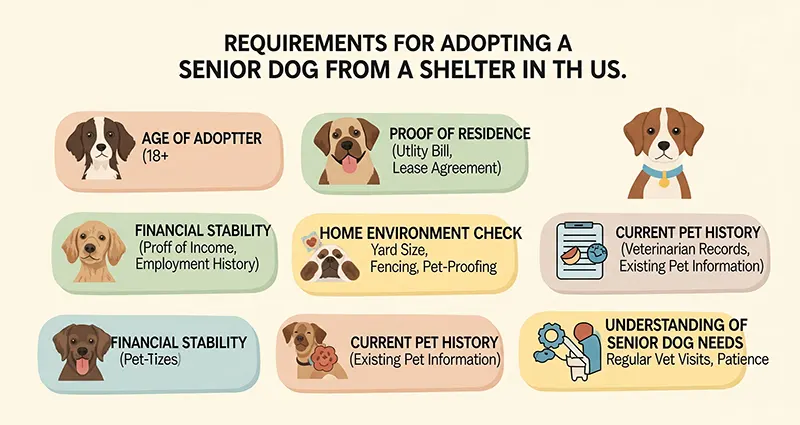Adopting a senior dog from a shelter is a rewarding experience that offers a loving home to a pet in need while gaining a loyal and gentle companion. Senior dogs often have calmer temperaments and well-established personalities, making them great pets for those seeking a more relaxed and affectionate furry friend. However, the adoption process for senior dogs in the US has specific requirements designed to ensure the well-being of the animal and a successful transition into their new home. Understanding these requirements can help prospective adopters prepare for this meaningful commitment.
1. Age and Residency Requirements
Most shelters require adopters to be at least 18 years old, although some may have a minimum age of 21. Additionally, proof of residency in the state or local area is commonly necessary. This can include a driver’s license, utility bill, or lease agreement to verify the adopter’s address.
2. Application and Screening Process
Adopting a senior dog typically involves completing an application form that assesses the adopter’s lifestyle, experience with pets, living situation, and readiness to care for a senior dog’s unique needs. Shelters may ask about existing pets, household members, and daily routines to ensure compatibility. Some shelters conduct interviews or home visits as part of their screening to confirm that the environment is safe and suitable.
3. Financial Preparedness
Senior dogs may require more medical care than younger dogs, including regular vet visits, medications, or special diets. Shelters often want adopters to demonstrate financial stability and willingness to provide ongoing health care. While adoption fees for senior dogs are sometimes reduced or waived to encourage adoption, adopters should be prepared for potential expenses related to pet care.
4. Commitment to Care
When adopting a senior dog, shelters emphasize the adopter’s commitment to providing a stable, loving home for the remainder of the dog’s life. This includes understanding the possible health issues and the need for patience and affection. Some shelters may ask adopters to sign an adoption contract agreeing to provide proper care and not to relinquish the dog without contacting the shelter.
5. Environment Suitability
Since senior dogs often prefer quieter surroundings, shelters may look for homes without excessive noise, activity, or young children that could cause stress. The adopter’s home should be safe and accessible for a dog that might have mobility issues or other age-related needs.
6. Meet-and-Greet Sessions
To ensure a good match, shelters usually arrange meet-and-greet sessions where adopters can interact with the senior dog. This allows both parties to assess compatibility and helps the shelter staff evaluate how the dog responds to the potential new owner and their family.
7. Post-Adoption Support
Many shelters provide post-adoption support, including advice on senior dog care and access to veterinary services. Some require follow-up visits or communications to ensure the dog’s well-being after adoption.
Adopting a senior dog from a shelter in the US involves specific requirements focused on ensuring the dog’s health, safety, and happiness in its new home. These requirements include age and residency verification, a thorough application and screening process, financial preparedness, commitment to long-term care, and suitability of the home environment. By meeting these requirements, adopters not only provide a senior dog with a second chance but also enrich their own lives with the companionship and love that only a senior canine friend can offer. If you are ready to open your heart and home to a senior dog, connecting with your local shelters and understanding their adoption procedures is the first step toward making a profound difference in a deserving dog’s life.












